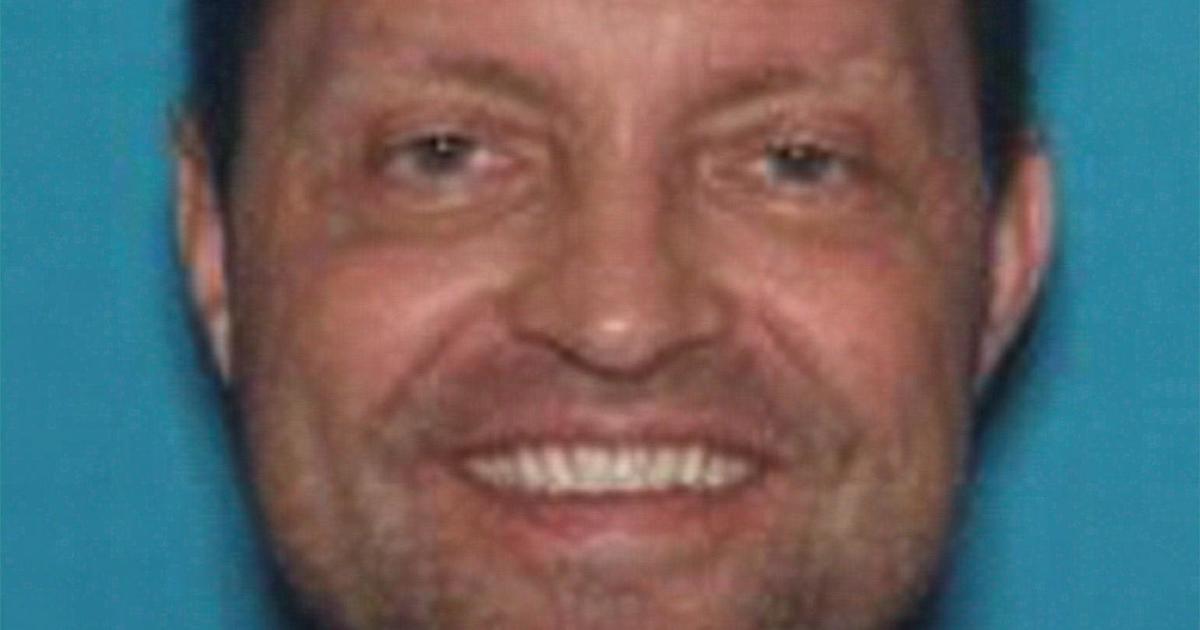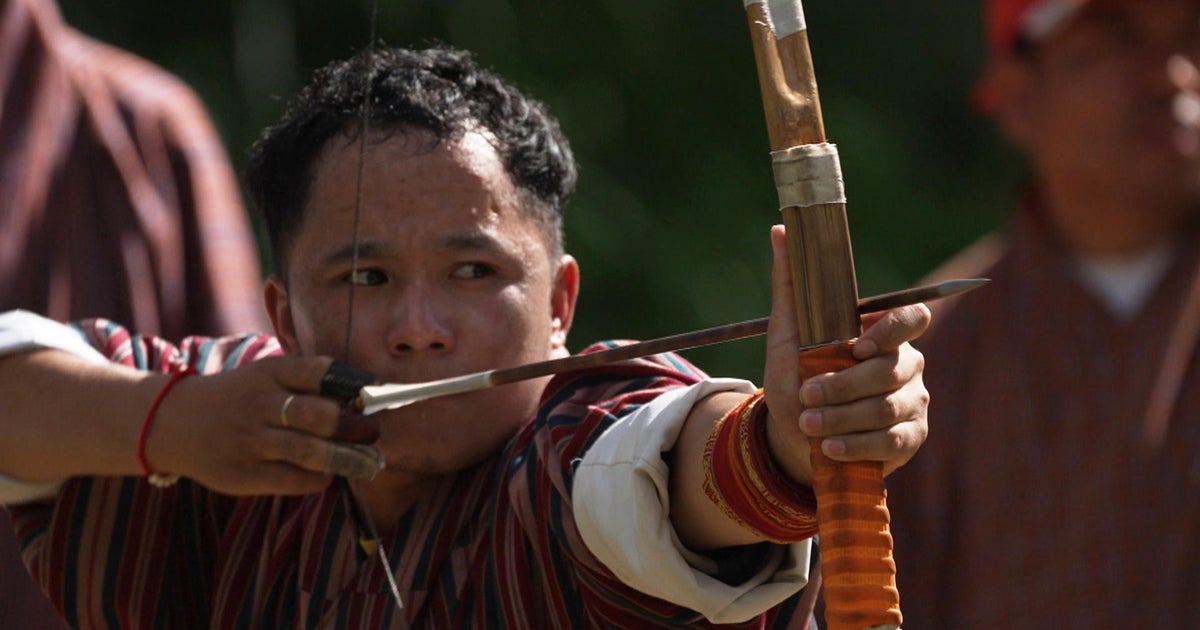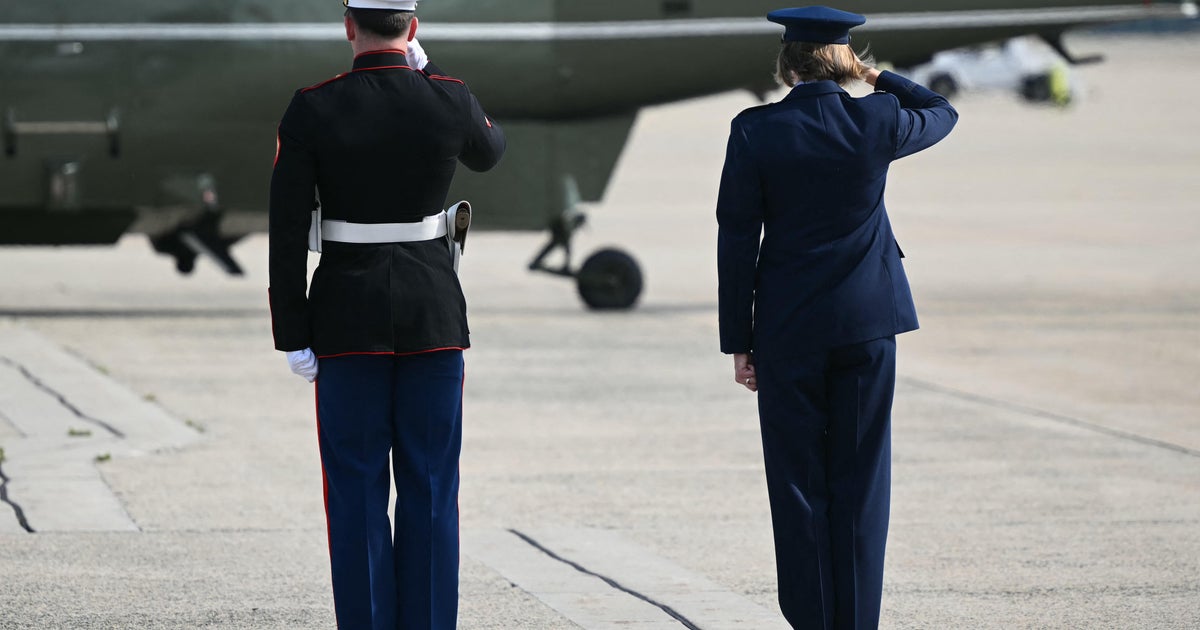CBS News
Missouri ER doctor whose body was found in Arkansas lake died by suicide, officials say

The death of a highly regarded Missouri emergency room doctor whose body was found 11 months ago in a northwest Arkansas lake has been ruled a suicide, Arkansas authorities said Thursday, in a case that fueled social media speculation about whether his disappearance had been tied to his cryptocurrency dealings.
Dr. John Forsyth, 49, was last seen nearly a year ago near the RV that he parked at the Cassville, Missouri, hospital where he worked. The father of eight who was engaged to be married didn’t show up for his shift at Mercy Hospital on May 21, 2023, prompting a search. There was no sign of him until a kayaker found his body May 30 in Arkansas’ Beaver Lake, about 20 miles south of the hospital.
/ AP
Detectives with the Benton County, Arkansas, sheriff’s office said Thursday that Forsyth died of a gunshot wound to the head. An autopsy by the chief medical examiner at the Arkansas State Crime Lab concluded the death was a suicide.
“Detectives have not been able to find any information or evidence that would lead us to dispute the medical examiner’s findings,” the sheriff’s statement said. “If objective and relevant physical evidence becomes available, those leads will be investigated on a case-by-case basis.”
The statement also said that as part of their investigation, sheriff’s officials found surveillance videos of Forsyth riding a bicycle to Beaver Lake. They said the bicycle was discovered near where Forsyth’s body was found.
The apparent mystery surrounding Forsyth’s death – and lack of details made public – brought his case national attention. He was engaged after divorcing a previous wife twice, and his brother, Richard, described him as excited about the upcoming marriage and a new child with his fiancee and had a plane ticket to go see one of his daughters.
Online publications covering cryptocurrency quickly took note of his death. His brother said after that before his brother’s death, John Forsyth had made cryptic remarks about being in danger.
Richard Forsyth told OzarksFirst there was one person who they believed was upset with his brother, but that individual was overseas, and he said he was confident the incident is not relevant to the investigation.
“He expressed some extreme emotions towards us that he would get revenge. And ultimately his campaign failed, and we didn’t hear from him again,” said Richard Forsyth. “I don’t see that being enough motivation for someone to cross the Atlantic and cause trouble.”
Richard Forsyth did not immediately return a telephone message seeking comment about the Benton County sheriff’s announcement.
John and Richard Forsyth founded Onfo LLC, what they called a “network mining” venture, in 2018. At that time, Onfo’s website said account holders could earn credits without putting up cash, by referring others to the company.
Richard Forsyth said after his brother’s death that the two of them were looking to give large numbers of people, including poor people in developing nations, a chance to invest in decentralized, digital currency. He said the brothers believed crypto had become driven by greed, “about Lamborghinis” and “billionaires and tax evasion.”
But the brothers’ crypto business wasn’t the only reason the case received attention as a Facebook discussion group grew to more than 1,000 members.
Only 10 days before John Forsyth’s disappearance, a judge had finalized Forsyth’s second divorce, requiring him to pay an additional $15,000 a month to his ex-wife and $3,999 a month to support four of their children. But the split was amicable, according to family members and the ex-wife’s attorney.
A week after John Forsyth vanished, his sister, Tiffany Andelin, wrote on Facebook that he had “disappeared, seemingly into thin air.”
“I’m grieving, I’m afraid, and it feels like the world has tipped into sheer chaos,” she wrote.
The sheriff’s department said the doctor was last seen walking toward his RV in the parking lot of Mercy Hospital in Cassville, 40 miles west of the Ozark Mountains tourist destination of Branson, Missouri.
But he was reported to have disappeared from the parking lot of a public swimming pool in Cassville, about a mile from the hospital where he worked, which hadn’t yet opened for the summer season. Richard Forsyth has said his brother’s car was found there, unlocked, with two cellphones, a laptop and important documents inside.
If you or someone you know is in emotional distress or a suicidal crisis, you can reach the 988 Suicide & Crisis Lifeline by calling or texting 988. You can also chat with the 988 Suicide & Crisis Lifeline here.
For more information about mental health care resources and support, The National Alliance on Mental Illness (NAMI) HelpLine can be reached Monday through Friday, 10 a.m.–10 p.m. ET, at 1-800-950-NAMI (6264) or email info@nami.org.
CBS News
Reclaiming the 9/11 dead – CBS News

In New York City, there has been a quarter-century-long effort to reclaim the dead.
On September 11th, 2001, the bodies of nearly 2,800 people were buried at ground zero, reduced to anonymous fragments in a grave made of concrete and steel. Most people know of the visible bravery in lower Manhattan that day, the nobility of the firefighters and first responders running up the stairs while everyone was coming down. Less well known was another group of first responders, whose tireless effort to identify the victims has been quietly ongoing since.
Today, new technology is helping the New York City Office of the Chief Medical Examiner keep a promise to do whatever it takes, as long as it takes, to put names to the remains.
Finding the fragments
To begin to identify the victims after 9/11, they first had to be found.
In the weeks and months that followed the attack, teams of government workers labored with tortured devotion to comb through the wreckage. And when two gargantuan skyscrapers falter and crumble beneath their own weight, it leaves a lot of wreckage: nearly 2 million tons in all. This mountain of debris where the World Trade Center towers once stood became known as “the pile.” Each worker in the pile became a kind of archeologist, digging into a certain prehistory of America — a time before the so-called war on terror — all laboring, in essence, to raise the dead.
“When we do have a recovery [of human remains], I don’t think of it as a bad thing. I think of it as the beginning of closure for families that have been through just pure hell,” Port Authority Police Department officer Dan Henry told 60 Minutes correspondent Scott Pelley in 2002.
Henry knew of such emotional perdition himself. He was there, in part, in pursuit of the remains of his brother, fireman Joseph Henry.
In his quest for closure, Dan Henry joined some 800 people who searched the wreckage every day. Their work persisted without pause for months, through weekends, weather, and holidays, not stopping for even one hour. They dug until they reached the bedrock of Manhattan.
With each bucket of debris in the pile, workers searched by hand, looking for human remains. Then, after everything had been examined, the rubble was piled on barges and sent across New York Harbor to Staten Island. There, workers sorted the wreckage and spread it over conveyor belts, where they again sifted it manually. They searched for anything that might identify a life: a wallet, a bone fragment, a wedding ring.
“I never give up hope that I’ll get his wedding band back that I want so desperately, or that I’ll get another phone call about some other remains,” Nicole Petrocelli LaMorte told Pelley in spring of 2002.
Petrocelli LaMorte’s late husband, Mark Petrocelli, was one of the victims whose remains were recovered and identified early on.
At the time she spoke with Pelley, Petrocelli LaMorte had been told about four separate recoveries of her husband, a commodities broker for Carr Futures. Petrocelli, who usually worked at the World Financial Center nearby, had left home early that morning to attend his first brokers’ meeting, held in the World Trade Center’s North Tower on the 92nd floor. Shortly after he arrived that morning, American Airlines Flight 11 crashed into floors 93 to 99. No one survived above the 91st floor.
While some family members of victims opted not to be informed when their loved one’s remains were identified, Petrocelli LaMorte told Pelley she chose to know every time. If he were sick and dying, she would have taken care of him, she said in 2002. So when any part of him was identified — as his heart was, for example, found alone outside his torso — she wanted to know and to bring the remains home.
At the time of that interview in 2002, the majority of families were still waiting for the first notification that their loved one had been identified. And in those months immediately after the attack, it looked likely that it would remain that way.
“But it’s important for the families to remember that the recovery, the identification process will continue at the medical examiner’s office for quite some time, probably almost a year,” Petrocelli LaMorte told Pelley at the time. “So there is hope.”
Identifying the victims
Both the work and the hope have endured longer than imagined.
One morning in December 2023, police officers knocked on Ellen Niven’s door. Niven was putting up her Christmas tree, and when she saw the officers, she first feared something had happened to her son. Instead, they were there to present a letter she thought might never come: a notice informing her that her late husband’s DNA had been identified for the first time.
Whether or not the news arrived as something of an early holiday gift, it was belated in other ways. On 9/11, Ellen’s husband, John Niven, was a 44-year-old insurance executive at Aon who worked on the 105th floor of the South Tower. After United Airlines Flight 175 struck the South Tower, another Aon employee, Kevin Cosgrove, also huddled on the 105th floor. Cosgrove’s wife was informed that her husband’s remains were found and identified a week after the attack in 2001.
But for two decades, Ellen Niven had not heard a thing.
“I was really blown away because I had no idea that for 22 years, anyone had still been looking, or sifting, or trying to find anything,” Niven said recently. “I just assumed that had all ended shortly after 9/11, when everything was cleared away.”
After the disaster, workers unearthed 15 of Niven’s bone fragments, and for years, scientists had tested and retested them. But they always came up short on extracting enough DNA for a match. According to Mark Desire, the assistant director of forensic biology at the New York City Office of Chief Medical Examiner, this has been a common issue with the human remains found within the wreckage.
“These remains went through every possible thing that could destroy DNA,” Desire told 60 Minutes, “from jet fuel to diesel fuel, mold, bacteria, sunlight, all kinds of chemicals that were in the building, insects, heat, fire. All these things destroy DNA.”
If any genetic data survived, today’s new technology will search for it. To extract DNA from bone, scientists first need to pulverize the bone into a fine powder. According to Desire, this process was done by hand with a mortar and pestle in the early days after 9/11. Today, the method involves a cryogenic grinder filled with liquid nitrogen at 320 degrees below zero. With high-speed vibration, individual cells in the deeply frozen bone shatter, and a chemical process releases their DNA.
New methods, including a combination of Y chromosomal technology and nuclear technology, made a breakthrough with Niven’s remains. Finally, more than two decades after his coworker was identified, scientists were able to link DNA in a bone fragment to a cheek swab taken from Niven’s son, Jack, in the days after the attack. At the time, Jack was just 18 months old.
The news of the match has brought memories of Niven back to friends and family.
“He was a very calm person, witty, very dry, great sense of humor. Sort of a benevolent chuckle,” Ellen Niven remembers. “He really was very open-minded. The older I’ve gotten, and the more time has passed, the more you appreciate qualities that he had that were really special.”
One special memory Niven holds of her late husband was the last time she saw him. It was the morning of September 11, 2001, and John had fed their young son cherry yogurt for breakfast before grabbing his briefcase and getting ready to leave. He was scheduled to fly to Denver that afternoon, and as he walked out the door, he told her, “Alright, I’ll call you later.”
For Kathy Haberman, the finite nature of memories like these is still hard to accept.
“I can’t look at pictures of Andrea now, because there’s never going to be another picture,” Haberman told 60 Minutes. “There’s never going to be another memory.”
Haberman’s daughter, 25-year-old Andrea Haberman, was on her very first business trip. Like Mark Petrocelli, she worked for Carr Futures, but as an administrative assistant to the company’s president, she was based in Chicago. She had never been to New York City before — indeed, had never even visited the East Coast — and was scheduled to fly out on Monday, September 10th.
Her flight from Chicago’s O’Hare airport was canceled twice, and after the second postponement, she called her parents to tell them that, if it were canceled a third time, she would postpone her flight until morning.
According to Haberman’s parents, she had already been nervous about the trip. She was acutely aware of the legacy of the 1993 World Trade Center bombing, a subject she wrote about for an English assignment in high school. Elizabeth Rydzik Biskobing, the English teacher who had assigned students to write an essay about an event in the news, told the Milwaukee Journal Sentinel that Haberman was the only student who chose to write about the bombing. Going beyond the assignment, Haberman even included her own disbelief at the terrorists’ brutality.
“She really threw me for a loop because she was so baffled by what happened,” Biskobing told the paper.
After finally landing in New York City late Monday night, Haberman reported for work around 8 a.m. the next morning — visiting the 92nd floor of the North Tower. Her boss, who had flown in that morning, was navigating traffic into Manhattan when the disaster happened.
“Thing is, she knew nobody there,” Haberman’s father, Gordon, told 60 Minutes. “That has always bothered me. She was alone and had this happen.”
Over the years, the Haberman family has been reminded of Andrea with every call from NYPD detectives. There have been 11 notifications so far to inform them that her remains have been identified, and each time, the family can feel that they are present for their daughter in death.
“She was beautiful both inside and out, intelligent, very smart,” Gordon Haberman said. “And she was very much looking forward to the future, all of us.”
One future event Andrea had been eager for was her wedding to her fiancé, Al Kolodzik. The two had just purchased a home together, and over Labor Day weekend, they had finalized details of their wedding, which was to take place the following year. The day after Andrea died, her parents say the postman delivered a thick manilla envelope containing the contract for the reception venue.
“To this day, I cannot look at her wedding dress,” Kathy Haberman said. “I never want to see it again.”
Haberman’s sister, Julie Osmus, remembers Andrea as outgoing in a quiet way. “She was just very precise on, you know, when she would talk and what she would say.”
“When she loved you, you knew it,” Osmus said.
Today, about 40% of 9/11 victims have yet to be identified. That means the families of 1,103 people at ground zero have never received that call of closure. But the work is ongoing; forensic biologist Mark Desire said samples are still being tested every week.
For those whom the medical examiner has contacted, the endless search to identify their loved ones’ remains has made it feel as though the nation has made good on its long-ago promise to “never forget.”
“I’m incredibly grateful, incredibly moved,” Ellen Niven said, whose late husband, John, was the 1,650th victim identified. “I had no idea that this was happening.”
Now remarried with two additional children, Niven said the experience of learning about her first husband’s identified remains has allowed her to reflect on how far she and their son, Jack, have come since that day. She said she does not think of it as closure, but something else.
“You do a lot of almost philosophical kind of soul searching, how important it is in human nature to either find a body, or find answers,” she said. “And even if this remain is infinitesimally small, there’s huge symbolism in that.”
The video above was produced by Brit McCandless Farmer and edited by Scott Rosann.
CBS News
Experiencing Bhutan’s ancient and wondrous traditions

This week on 60 Minutes, correspondent Lesley Stahl reported from Bhutan, a small, remote country tucked away in the Himalayan mountains.
The Buddhist kingdom is known for its awe-inspiring mountains, pristine forests, beautiful temples and spirituality.
“I am not a spiritual person. But I had all kinds of emotional reactions to the beauty of Bhutan,” Stahl told 60 Minutes Overtime.
“Snow-capped mountains, lush forests…it’s charming, absolutely charming.”
Stahl arrived at Paro International Airport on a small plane from New Delhi, landing on a runway flanked by steep mountains.
“As you look out the window, you can see yourself coming down these steep mountain slopes. It’s hair raising. It’s also one of the most beautiful sights ever,” Stahl said.
Buddhism is the state religion in Bhutan, and it is practiced by most of its citizens.
On any given day, many people, young and old, can be seen at temples spinning prayer wheels, large cylinders made of wood, as they walk past.
Stahl spoke with Dr. Lotay Tshering, a former prime minister of Bhutan, in the center of the town of Gelephu, and he explained how the prayer wheels work.
Tshering told her they are filled with millions of written prayers, and people spin them, wishing for longevity in life or the well-being of the world.
As the wheel is turned clockwise, the devotee mentally recites a wish that they hope will come true.
“Even now, I’m making my wish,” he told Stahl.
“Whatever reasons why 60 Minutes is making this…running this project, let it come to fruition. That’s my prayer, wish for the day. So, yes, these are very significant in our lives.”
While the team was in the country’s capital, Thimphu, they saw a festival called the Thimphu Drubchen, with ceremonial dances, known as cham, that take place every year.
Masked dancers perform precisely choreographed dances to a packed audience of Bhutanese to celebrate the female deities that they believe offer them protection.
Watching from a balcony overlooking the courtyard of the Tashichho Dzong, a fortress-like monastery and administrative center where the festival is held, Stahl spoke with Prime Minister Tshering Tobgay.
“This particular ceremony in Thimphu has been going on… uninterrupted, every year, for more than 400 years,” he told Stahl.
He told Stahl that while the spectacle is entertaining and enjoyable, bearing witness to it has a sacred religious purpose.
“Just by witnessing these dances…we believe that we receive blessings to protect us for a whole year.”
In a grassy field in Thimphu, Stahl watched an archery match with Rabsel Dorji, who works for Bhutan’s government.
Two teams of archers, using traditional bows and arrows made of bamboo, took aim at a target roughly 145 meters away, the length of a football field and a half.
“[The target] is quite far away and quite small. It’s only about three feet high and… one foot wide. So, it’s a difficult task,” Dorji told Stahl.
Dorji explained that, depending on where the arrow hits, the team is awarded one or two points. The first team to 25 points wins a game. The team that wins the best out of three games wins the match.
But points can be deducted from a team if the opposing team hits the target afterward.
“The game can go very, very long into a whole day…or a whole two or three-day affair,” Dorji said.
Stahl reacted with surprise when she saw a team singing and dancing after they hit a target.
Dorji explained that it’s the equivalent of an end-zone dance. “It’s a Bhutanese version of it,” he said, laughing.
Stahl told Overtime that throughout her travels it was visibly apparent that Bhutan was still firmly connected to its ancient past.
“A lot of countries in the world have [become] so Westernized that they’ve lost their character. Here, they have kept their old traditions… they’ve kept their old architecture. They wear old-fashioned clothes,” she said.
But Bhutan is facing an economic challenge that has made its future uncertain: young people are leaving the country for higher-paying jobs in countries like Australia.
Stahl and the 60 Minutes team were given a rare audience with the king of Bhutan, who described his plans to build a new city, the Gelephu Mindfulness City, in the country’s south, near the border with India.
The king hopes the new city will provide job opportunities that will bring these young people back.
“The king’s concept is that there will be a modern city, but it’ll be Bhutanese. Buddhism will be at the heart of it. Clean air, clean water,” she told Overtime.
The king hired renowned Danish architect Bjarke Ingels to design the new city. Ingels showed Stahl renderings for several projects, including a massive, colorful dam that will be used to generate hydroelectric power.
“And in the middle of the dam is a temple, right in the middle of the dam,” Stahl said.
“You have to hope that this little country can succeed in holding on to its character, its spirituality.”
The video above was produced by Will Croxton. It was edited by Sarah Shafer Prediger.
CBS News
Who President-elect Trump has selected for his Cabinet | 60 Minutes

Watch CBS News
Be the first to know
Get browser notifications for breaking news, live events, and exclusive reporting.








